Motorola Xoom 2 Review
Motorola Xoom 2
The Xoom has hit the gym to earn the abs of the cool tablet kids. But is it worth £380?
Verdict
Pros
- Very slim
- Great build quality
- Decent screen
Cons
- Non-expandable memory
- No touch focusing on camera
- No Android Ice Cream Sandwich, yet
- Non-aggressive pricing
Key Specifications
- Review Price: £379.99
- 10.1in 1,280 x 800 pixel display
- 1.2GHz dual-core processor
- 5-meg and 1.3-meg cameras
- Android 3.2 Honeycomb OS
- 8.8mm thickness
The original Motorola Xoom was the first Android tablet to get an official stamp of approval from Google. But its early headline-grabbing promise was fairly soon washed away by the ultra-thin Samsung Galaxy Tab 10.1, the ultra-pricedropped HP Touchpad, the ultra-Apple iPad 2 and, of course, our tablet of 2011 the Asus Transformer. The Xoom 2 is Motorola’s second attempt at a 10.1in tablet. It’s thinner, it’s lighter and it’s faster than its forebear. But will it convince the masses to shell out just under £400, when its predecessor largely failed?
The second generation of 10.1 Android Honeycomb tablets has predictably seen several manufacturers follow the pattern set by Apple in its transition from the iPad to the iPad 2, in cutting down weight and thickness significantly. Motorola is among them. The original Xoom’s 12.9mm body and 730g weight have been shrunk to 8.8mm and 599g (601g according to our scales). That’s exactly the same thickness, and within a gram or two of the iPad 2. Coincidence? Of course it’s bloomin’ not.
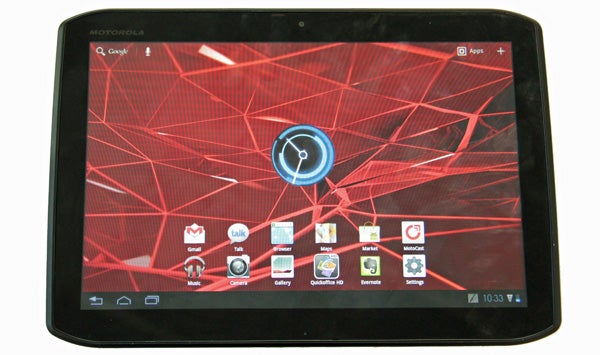
Not that we’re accusing Motorola of copying Apple’s homework, as the design is actually fairly different. Like most Android tablets, it’s widescreen (16:10), with a 10.1in 1,280×800 pixel display as opposed to the iPad’s 4:3 aspect, 1,024 x 768 pixel panel. The back is also made up of three slabs rather than a single seamless field of anodised metal. Rather like the Samsung Galaxy Tab 10.1, part of it has a soft touch finish. The edges – when held horizontally – use this finish, avoiding the cold, hard touch of metal.
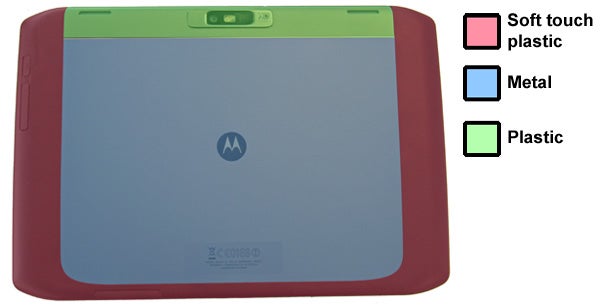
Most of the back is covered in metal, mind, bringing the high-end premium feel that’s a must-have for any tablet costing hundreds of pounds. Motorola has taken the easy engineering route for the tablet’s connections though, carving them into the black plastic sides and the grey plastic top section rather than into aluminium. This top grey part is meant to look mostly like a continuation of the metal plate below, but on close inspection the finish is a little different, which is a shame.
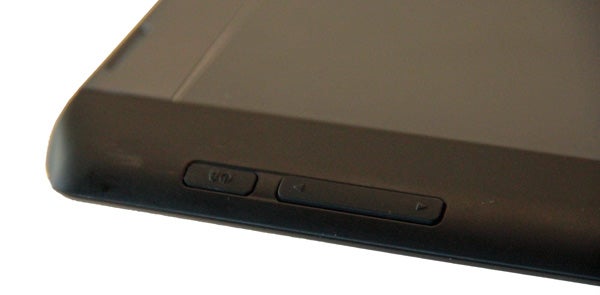
Up top within the grey plastic there’s a 3.5mm headphone jack, the camera lens housing and the stereo speaker grills. All the serious connectivity extras are on the bottom – the microSD slot and a microHDMI video output, next to a subtle black flap that hides the SIM slot (filled-in on our Wi-Fi only sample) and the place where the microSD slot should have been.
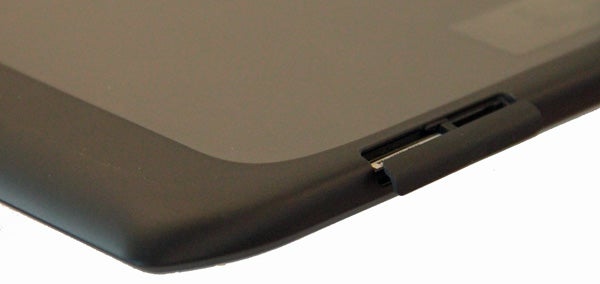
The flap of eternal nothingness
Yes, memory is non-expandable here and the standard model comes with only 16GB of internal storage – enough to get going but a paltry amount compared to the 64GB of top end iPads. Motorola claims expandable memory is no longer needed in a tablet, but we disagree. And taunting us with a spot where the microSD slot clearly once was is just cruel.
We wouldn’t go as far as to say the Motorola Xoom 2 is unattractive –
far from it. It’s slim, light, dense, and has cute lopped corners that
help to differentiate it from the many black Android slabs available to
buy. But its good looks are those of a TV actor rather than a movie
star. Chiselled and toned perhaps, but there’s something amiss that you
can’t instantly put your finger on.
It’s the redundant flap, the
relatively abundant seams and the overly ornate camera lens area.
However, it’s only something we notice so much because of the high
standard set in the tablet market, and build quality here is excellent -
on par with the best. Motorola claims it is splash-proof too thanks to
the entire machine’s innards being coated in water repellent. Not fit to
dunk in a bath for long periods like a Defy, perhaps, but it won’t fry as soon as it gets near water.
Other
hardware bonuses the Xoom 2 can shout about include the use of a
standard microUSB charging socket, where several others use proprietary
solutions, and its subtle hardware buttons. There are none on the front
but a volume rocker and power button are to be found on the back right
edge, where they fall neatly under your fingers. The Xoom 2 can charge
over a USB connection to a computer, as well as the included AC adaptor.
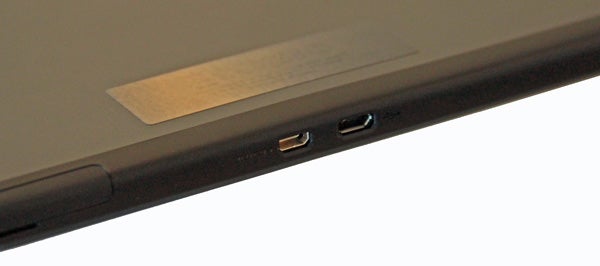
Without
expandable memory or a full-size USB slot, connectivity might be
considered a tad rudimentary, but it excels on the wireless front. The
Motorola Xoom 2 has a built-in IR transmitter, which can be used with
apps like Dijit to turn the tablet into a universal remote. Most Android
devices would need an IR accessory such as Griffin’s £40 Beacon to
achieve the same effect. Dijit is no replacement for a high-end Logitech
Harmony remote at this point, though. The interface is simple enough,
but the setup process isn’t.
The Xoom 2 is also a bit obsessed
with wireless transfer of files. Using the MotoCast desktop app, you can
stream and download files from your computer over a Wi-Fi connection, or from anywhere round the world if you leave your PC on.
The installation files for this software are included on the tablet
itself, showing up as a discrete 70MB drive when plugged in.
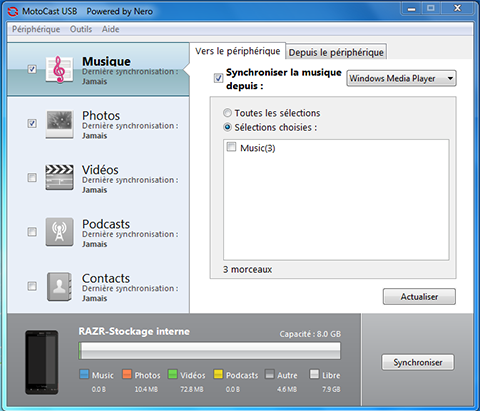
The simple Motocast UI, en Francais
However,
you can only freely transfer files to the rest of the internal memory
using a cable once this software has been installed, seriously hampering
the plug and play versatility of the device. We’d much prefer the
simplicity of a mass storage mode – which would make the 16GB of
internal memory (12GB user accessible) show up as a disk drive as soon
as you plug the Xoom 2 in – but there is no such mode here. More storage
black marks for Motorola.
Ice Cream Sandwich, the version of the Google Android OS that will once again reunite the smartphone and tablet sides of the system, is out and working in devices already, but the Motorola Xoom 2 ships with Android 3.2 Honeycomb at present. It’s better-suited to large 10.1in screens than the smartphone version of the software, with a better-integrated notifications system that borrows design elements from desktop operating systems like Windows and Mac OS.
Down the bottom is an interface bar that holds a clock, any recent notifications plus three nav buttons – back, home and recent apps. As Honeycomb doesn’t rely on hardware navigation buttons, these three little touchscreen squares are key parts of the Android Honeycomb experience. Just as important is the apps menu shortcut right up at the top of the screen. This button and the home button take you to the two “halves” of the OS – the home screens and app menu. 
Home screens and…
To anyone who has used Android before, this will seem as though we’re explaining the alphabet or why it gets dark at night, but if you’re of Apple stock, it’s important to consider whether this different style of OS will be your bag. It allows for plenty of customisation and fiddling, and home screens can be bunged full of widgets and shortcuts. However, it’s less immediate and simple than iOS – which is little more than a window to an app menu.
Ice Cream Sandwich, the upcoming version 4.0 of the software, doesn’t significantly deviate from HoneyComb 3.2. It just makes it work a little better, which is something that Android for tablets needs – it doesn’t offer as pleasurable and “complete” an experience as iOS or Android for smartphones.

…the apps menu
Motorola has confirmed its intention to bring Ice Cream Sandwich to the Xoom 2 within six weeks of the system’s public launch. Having spent many a month waiting for an Android update to land, we’d advise taking any such claims with a dose of salty scepticism – although all tablet manufacturers are in a similar position right now.
In the meantime, Motorola has thankfully not made any bold customisations of the Honeycomb OS. There’s a little icon stuck in the bottom menu bar, giving you easy access to a little, very basic, notepad that floats on top of the home screen, and the clock font seems to be a custom addition, but the rest of the layout is the bog-standard one we’ve grown all-too accustomed to over the last year.
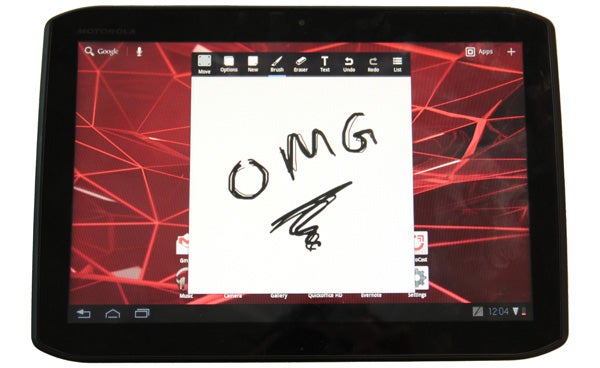
Floating notes – take notes without leaving the home screen
The Xoom 2 is crying out for Ice Cream Sandwich, as it can be argued that, weight loss aside, the Xoom doesn’t feel massively different in operation from its predecessor. Its mild obsession with note-taking is… notable given that Motorola also offers an official stylus (not supplied as standard, £25), but as it’s a standard active capacitive stylus rather than anything fancier it’s no reason to favour the Xoom 2 over any Honeycomb rival.
Like every Android Honeycomb tablet, the Motorola Xoom 2 uses a capacitive touchscreen. And like almost every one of these touchscreens, it’s responsive and a pleasure to use. It can sense up to 10 different points of contact at once, making it among the top capacitive touchscreens around. And it would take quite an imagination to come up with a reason to need more than 10.
The screen is topped with Gorilla Glass. This is also a common feature in Honeycomb tablets, but remains worth noting. It’s highly scratch-resistant and feels great under your finger. Hard plastic alternatives just can’t match a good glass surface.
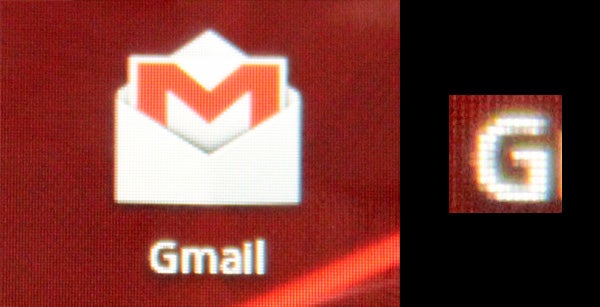
Sharp, but you can see the pixels if you try hard enough
This surface is highly reflective, though, making reflections problematic as soon as you step outside with the device, though this is of course a problem with all glass fronted tablets. More of an issue is it also seems to be much less oleophobic than the iPad 2’s screen – as in it picks up greasy finger smudges very easily, and is less keen to let them wipe away. Within a couple of minutes of use, it was a bonafide smudgefest.
Under all the greasy smudges and high-quality glass is a 1,280×800 pixel 10.1in IPS panel. This supplies superb viewing angles, good contrast and fairly vivid colour. Its maximum brightness isn’t a patch on the IPS screen of the Asus Eee Pad Transformer Prime – although it is on a similar level of performance as the original Asus Eee Pad Transformer and other IPS-equipped tablets. 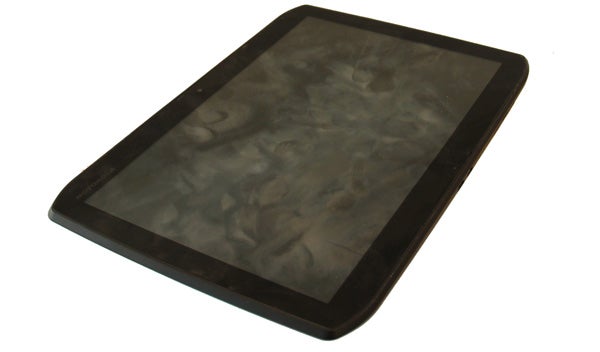
No greasy crisps were consumed to produce this image
The screen represents a significant upgrade over that of the first Xoom. It didn’t use an IPS panel, and viewing angles suffered accordingly. However, within the next 12 months we’re likely to see tablet screens take a big leap forward, with much higher pixel density top of the wish list. While the 149dpi of the Xoom 2 seems plenty sharp enough for now, and is noticeably sharper than the 1,024×768 screen of the iPad 2, you can bet we’ll look down upon it as antiquated by this time next year. Then again, the same could be said of all the current crop of tablets.
One area where the limitations of a 149dpi display become apparent is browsing. Zoom out and you’ll see that tiddly text isn’t all that smooth – although less so than on an iPad 2. Nevertheless, the Xoom 2 excels in this web-connected area. The built-in browser is quick, supports Flash 11 following a quick trip to the Android Market app store, and text rescaling is super-fast. Adobe has announced that it plans to stop development of Flash for Android, though, so this notable advantage will wither and fade over the next year.
The Motorola Xoom 2 has a 1.2GHz dual-core Tegra 2 processor. In pure clock speed terms, that’s more grunt than the iPad 2, the previous Xoom and the Galaxy Tab 10.1. All of those tablets feature a 1GHz dual-core chip (some versions of the Tab 10.1 reportedly run at 1.2GHz).
As neat a power boost as this is, quad-core tablets using the Kal-El chip – the successor to the Tegra 2 – such as the Transformer Prime are beginning to appear. But what are the key advantages of getting so much more power, when few apps and games make use of a 1GHz dual-core processor, let alone the 1.2GHz CPU of the Xoom 2? 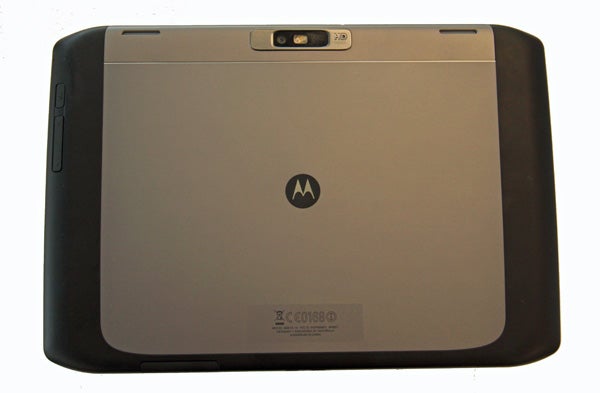
For many, quad-core power will be useful for playing high bit-rate 1080p video (the experiential benefits of which will become much clearer when higher res tablet screens arrive) and games designed with the Kal-el chip in mind. A slew of games were optimised for the 1GHz Tegra 2 chipset, after all – although a recurrence of such a trend is by no means guaranteed. The arrival of the quad-core brigade represents the first serious fragmentation at the top end of the tablet market, and it’s not clear yet how game developers will react to this.
However, if gaming is a key priority you should be looking at an iPad 2 rather than an Android tablet. Quad core renaissance or no, the catalogue will not touch that of the App Store.
Enough of what you’re missing out on, though. The Xoom 2 can play a limited selection of video formats using its built-in Gallery media player, including Xvid and DivX alongside the Android standards of H.264 and WMV. However, it failed to play our test MKVs and struggled through even our non-taxing standard definition videos, refusing to play an SD Divx vid without dropped frames. This is a software limitation, and can be partly patched-up by downloading a third-party media player. However, these are frequently buggy and under-optimised, usually relying
on software decoding rather than making full use of the hardware. Only
Samsung has successfully patched-in decent native video support to its
Honeycomb devices, and we doubt Motorola will update the tablet to
remedy this issue. Of course, this could be seen as primarily a concern
of pirates – in pirate coves is where MKV flourishes – but when a
natural use for a 10.1in widescreen portable display is TV and movie
watching this is a feature hole we have never understood. Get your
videos transcoded to H.264 and the internal battery is good for around
nine hours of video-watching, putting it up there with the
longest-lasting tablets.
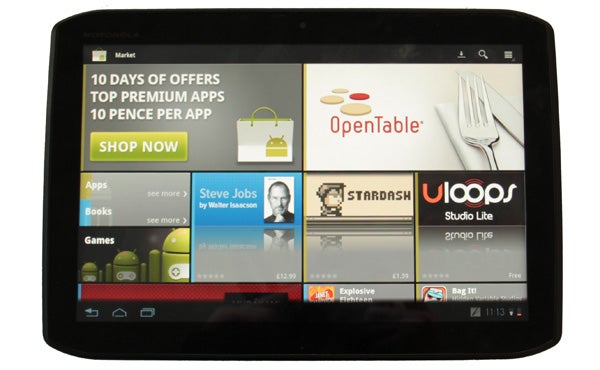
The new-look Android Market
Tablets are arguably more about apps than video, though. The Android Market app store has recently been given a trendy new interface that makes scanning over its surface a richer experience than before. However, the issues of quality, consistency and, in some cases, quantity of content still exist. That Android users aren’t willing to pay for apps is a widely-accepted notion, a largely true one as well, and naturally this limits the amount of money developers are willing to pile into the platform. Games giant EA has released 12 games for Android (not specifically tablets, either) and 43 for iPad. And thanks to Android fragmentation, only five are available from the Android Market on a Xoom 2 at present. The “there’s an app for that” saying often pinned to iOS doesn’t apply to Android if your needs spread to niche or esoteric areas.
One thing to bear in mind is that the Xoom 2 carries hardware data encryption and VPN support so it’s ready to go for secure business applications. It also has an inbuilt printing app called Motoprint that means you can easily wirelessly print from certain applications. Combined with the pen interface and IR transmitter, there are some interesting potential uses here, though none of them quite compel for everyday consumer use.
The Motorola Xoom 2 has two cameras – a 1.3-megapixel user-facing sensor for video calling and a main 5-megapixel camera equipped with a single-LED flash. Taking photos with a tablet will do nothing for your street cred, and Motorola seems to have realised this, as these specs are slightly lower than those of the first Xoom, which had a dual-LED flash and a slightly higher-res secondary camera.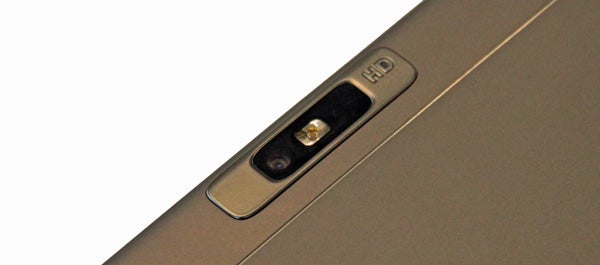
Motorola hasn’t fiddled with the vanilla Android Honeycomb photo experience, using the camera UI that comes with the OS. This lets you change the white balance and apply a handful of effects, but lacks other fun extras such as panorama, smile shot, touch-to-focus and timed shooting. Much like the basic video support, you can easily add most missing features with apps from the Android Market.
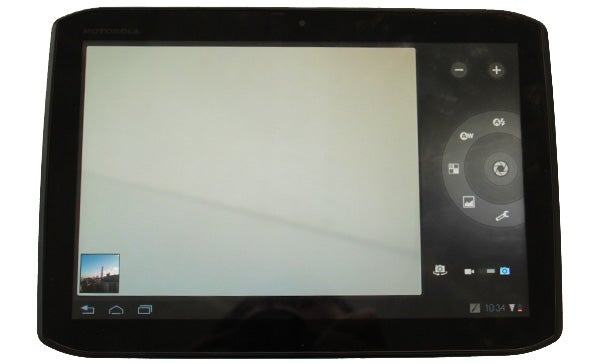
Colour is slightly muted in photos and not being able to manually select your subject is disappointing. It doesn’t excel beyond the previous Xoom, and is shamed by the top smartphones. We’re still of the opinion that the most useful camera is the one pointing towards you when it comes to tablets, and the built-in Google Talk app lets you video call folk. The standard camera app also lets you capture 720p video using the 5-megapixel sensor. However, features like these would be more conspicuous in their absence – they’re that common.

That the Xoom 2 is, for the most part, a collection of many common, familiar features and specs is its greatest problem. It’s thinner and lighter than the old model, but it’s ultimately not hugely different in use, and does little to make the £380 price seem like a bargain. There are the business-oriented extras but with uptake of tablets for serious applications still so slow and task dependent there’s little to really get excited about – the features really just tick the box that certifies this tablet ready for such things.
Tablets like the Kindle Fire suggest that new waves of Android tablets need to focus on staying as far away from the £400 entry point as possible – just because it works for Apple doesn’t mean it can for everyone else. Expensive Android tablets are by no means a no-go, but they need to do something more dynamic than the Xoom 2 at this point – the Asus Eee Pad Transformer Prime being a good example of the pricey Android done right. When previous-gen devices such as the first Transformer can be found for a full £100 less, that the biggest upgrade is losing a millimetre or two of girth isn’t all that compelling.
Verdict
The second Motorola Xoom 2 is much thinner and lighter than the original. The screen is better and the processor more powerful. However, there’s an element of treading water to the design as it doesn’t improve upon more recent rivals much. An IR transmitter, inbuilt printing function, MotoCast and a few secure business options make for some interesting potential uses but for the average consumer these aren’t overly compelling. A relatively staid approach, when combined with the non-expandable memory and fairly high £380 price, ensures it can’t topple the greats, and won’t sway many iPad 2 owners-to-be.
How we test tablets
We test every tablet we review thoroughly. We use industry standard tests to compare features properly and we use the tablet as our main device over the review period. We’ll always tell you what we find and we never, ever, accept money to review a product.
Trusted Score
Score in detail
-
Performance 8
-
Value 7
-
Design 7
-
Screen Quality 8
-
Battery Life 8
Other
| Processor | Tegra 2 |
| Memory (RAM) (Gigabyte) | 1GB |
| Mobile Broadband/3G | No |


